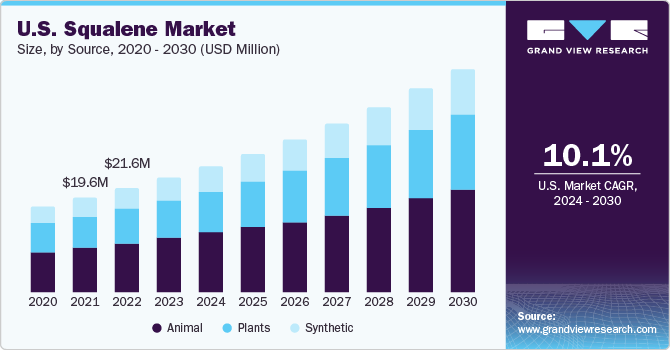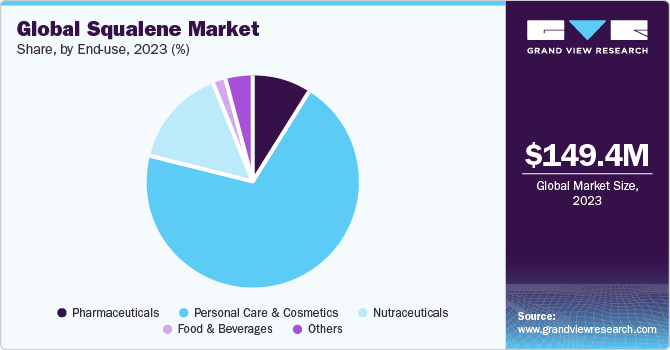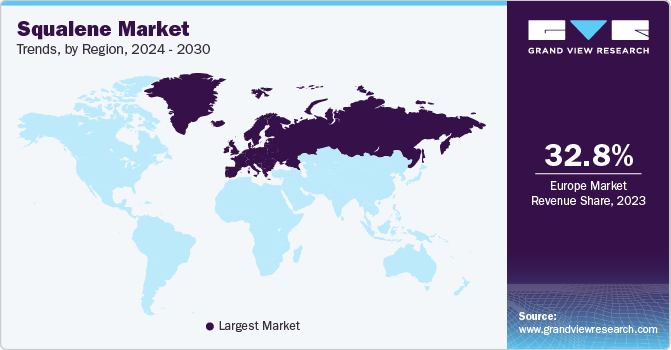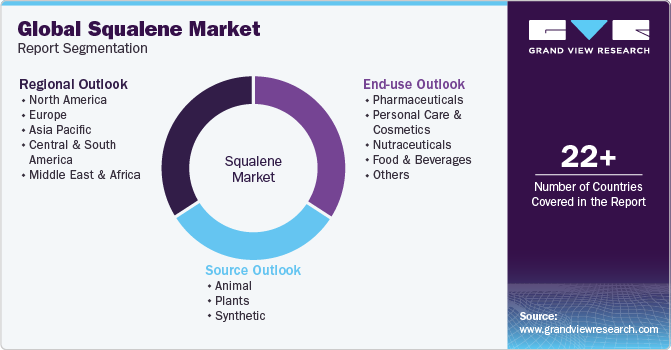- Home
- »
- Food Additives & Nutricosmetics
- »
-
Squalene Market Size, Share, Growth & Trends Report, 2030GVR Report cover
![Squalene Market Size, Share & Trends Report]()
Squalene Market Size, Share & Trends Analysis Report By Source (Animal, Plants, Synthetic), By End-use (Pharmaceuticals, Nutraceuticals), By Region, And Segment Forecasts, 2024 - 2030
- Report ID: 978-1-68038-991-3
- Number of Report Pages: 140
- Format: PDF, Horizon Databook
- Historical Range: 2018 - 2022
- Forecast Period: 2024 - 2030
- Industry: Specialty & Chemicals
Squalene Market Size & Trends
The global squalene market size was estimated at USD 149.4 million in 2023 and is expected to grow at a compound annual growth rate (CAGR) of 10.9% from 2024 to 2030. Increasing consumption of natural ingredients in the personal care and cosmetics sector is expected to emerge as a major factor driving the market demand. Squalene is translucid, emits a low odor, and offers moisturizing properties. These qualities make it one of the most preferred emollients in the world. Absence of toxicity, makes it one of the most widely used elements in personal care applications. Squalene oil is also utilized in the cosmetics industry to fight free radicals that damage the skin and accelerate the aging process.

The product is used as a moisturizing and cleansing ingredient in cosmetic and personal care products such as lotions, hair conditioners, bath oils, lipsticks, creams, and foundations. Furthermore, surge in demand for natural and organic ingredients is expected to have a positive impact on the market.
Another factor that fuels market expansion is the rising demand for products in several vaccines. It is a vital component of vaccinations including the COVID-19 vaccines as it is extremely effective in boosting immune response.
Squalene product, used in vaccines and pharmaceutical products is a purified version of fish oil, which is extracted from sharks. A report published by the International Trade of Endangered Species states that five shark species are in danger of extinction. This is anticipated to significantly reduce animal-based products and further drive plant- and synthetic-based sources.
The squalene industry also benefited from rising interest in nutritional supplements, expansion of the cosmetics sector, and prevalence of cancer and cardiovascular disorders. New renewable sources for product manufacturing along with appealing marketing and packaging techniques give market participants additional lucrative opportunities.
The U.S. is the largest producer and consumer of the product in North America. The market is expected to grow significantly over the forecast period owing to growth of the cosmetics industry in the country. The growth can be attributed to a high penetration rate of global cosmetic brands and an increase in demand for beauty care products and beauty clinics owing to the expanding working women population in the country.
The product is mainly extracted from shark liver oil and olive oil. Olive oil is a major source of extraction in the U.S. owing to restrictions imposed on poaching of marine animals under Marine Mammal Protection Act Policies (MMPA) that prohibit the take of marine mammals, including hunting, collecting, capturing, harassing, or killing them in waters and by citizens of U.S. on the high seas.
The act also makes it unlawful to import marine mammals and items derived from marine mammals into the country without necessary permits. This could lead to an increase in the use of plant-based or synthetically manufactured products over animal-based in the U.S. in coming years.
Market Dynamics
The European Union has banned the use of shark oil-based products in the cosmetic industry, which has further forced manufacturers to focus on finding suitable alternatives for the product. Increasing concerns regarding the extinction of sharks have prompted use of plant-based and synthetically derived products. Its extraction has shifted towards plant-based oil that includes rice bran, amaranth olive, and others. About 65% of olive oil exports are produced, consumed, and exported by the European Union.
Squalene-based adjuvants have been utilized in flu vaccinations for over 20 years because of their improved immunogenicity, increased heterologous antibody responses, and potential for antigen dosage sparing. They were recognized by numerous agencies and served as a vital substance in health emergencies like influenza. The COVID-19 vaccine contains squalene due to many benefits associated with animal-based squalene such as its usage as an immunity booster. For instance, to produce vaccines made from squalene, GlaxoSmithKline has partnered with a number of businesses including Sanofi S.A. and CureVac N.V.
Source Insights
The plant segment dominated the market with a revenue share of over 82.3% in 2023. This is attributed to the declining population of sharks, increasing awareness among people regarding animal welfare and protection, and regulatory frameworks imposed by various governments for the protection of marine animals.
Plants are alternatives to sharks for extraction of the product as they can be grown and harvested sustainably. For example, the monkey Jack, or Artocarpus lakucha is an Asian plant that produces 10%-20% of its product, equivalent to its dry weight capacity. The product can also be extracted from its leaves having high purity.
As per the International Olive Council (IOC) report, world olive oil production may reach 3,214, 500 tons, 2.9% more than the previous crop year due to high cultivation of olive trees in this region. Naturally, squalene is majorly found in olives, amaranth, and rice bran. The highest amounts of product are found in olives depending upon cultivator, extraction technology, and level of oil refining. Extra virgin unrefined olive oil contains higher concentrations of the product as compared to refined olive oils.
Shark squalene is obtained from liver oil of freshly preserved livers of numerous species of deeper water sharks as they have higher product content. It requires around 3000 sharks to extract just one ton of product, hence excessive catching of these animals led to a dramatic decline in population of certain species as around 2.7 million deep-sea sharks are poached every year due to wide application in the cosmetic industry.
Deep-sea shark liver oil has been a primary and highest concentration of naturally occurring source of product, owing to its properties such as healing wounds and fighting infections as it stimulates a key innate immune cell in wound healing and tissue repairing.
To protect these sharks and shift manufacturers to use plant-based product sources, several laws were imposed. In India, extraction, possession, or trade-in 10 elasmobranchs is completely prohibited as they are listed in India's Wildlife (Protection) Act, 1972.
End-use Insights
The personal care and cosmetics segment dominated the market with a revenue share of over 70.1% in 2023. The growth in this segment can be attributed to the usage of squalene in a variety of cosmetic products meant for skin care and hair care.
Squalene is used in a variety of cosmetic products meant for sun care, skincare, and hair care. Approximately 70-80% of the total product produced globally is consumed by the cosmetics industry. Multinational cosmetic companies such as L’Oréal, Unilever, and St. Botanica have already started to shift from shark liver oil-based to plant-based products for use in their personal care products and cosmetics owing to its exceptional properties, along with less extinction risk posed by them to sharks.

In 2021, L’Oréal acquired U.S.-based ‘Youth to the people’, which has branches in Canada, the U.S., Australia, and some European countries. The brand offers skincare products developed from plant extracts. This acquisition helped L’Oréal use plant-based products in its cosmetic products rather than shark-based.
Regional Insights
Europe dominated the market with a revenue share of over 32.8% in 2023, followed by Asia Pacific region. This is attributed to large-scale production of olive oil, which is a major plant-based source of product, and increased demand for the product from major economies such as Germany, France, UK, Italy, and Spain, in the region.

As of 2023, Europe accounted for a significant share of olive oil production. Italy, France, and Spain are a few among nine producing member countries in the region. Spain accounts for more than half of the total area under olive groves in Europe. Squalene manufacturers in this region are switching to production of plant-based squalene from shark-based ones.
According to the European Federation of Pharmaceutical Industries and Association (EFPIA), the pharmaceutical industry had one of the largest research and development budgets in France in 2021. It accounted for a 9.8% share of overall pharmaceutical revenues in 2021.
Pharmaceutical manufacturers in France are continuously investing in research and development activities for producing innovative and effective medicines developed from bio-based ingredients to ensure environmental safety. This, in turn, is expected to lead to the increased consumption of plant-based products in the pharmaceutical industry in the country over the forecast period.
Germany imported approximately 85 tons of olive oil in 2020 owing to increasing demand for olive oil from health-conscious consumers and surging usage of plant-based products in various end-use industries such as personal care products and cosmetics, nutraceuticals, and pharmaceuticals. Companies such as L’Oréal in Germany have switched from usage of animal-derived to plant-derived squalene in their products.
The growth of the market in Asia Pacific can be attributed to easy availability of raw materials, cheap labor, low costs of setting up manufacturing units, and expansion of industries such as personal care products and cosmetics, pharmaceuticals, nutraceuticals, and food & beverages in regions that utilize squalene.
Key Companies & Market Share Insights
The market is fragmented and competitive with presence of several players. Major players are clustered in European and North American regions, whereas several small players are clustered in Asia Pacific, mainly in India, China, and Japan, as the region offers easy access to shark liver oil and olive oil, which are essential raw materials for production of the product.
Partnership strategies have been adopted by the leading players in the market to enhance the reach of their products by leveraging the networks of acquired players and geographic availability. For instance, in May 2023 Amyris announced its partnership with Croda International Plc. in order to supply pharmaceutical-grade squalene in adjuvants to boost the immune response.
Key Squalene Companies:
- Amyris, Inc.
- Sophim SAS
- Henry Lamotte Oils GmbH
- efpbiotek
- Vestan Limited
- Kuraray Co., Ltd.
- Croda International Plc
- AASHA BIOCHEM
- Arbee
- Oleicfat, s.l.
- Kishimoto Special Liver Oil Co., Ltd.
View a comprehensive list of companies in the Squalene Market
Squalene Market Report Scope
Report Attribute
Details
Market size value in 2024
USD 165.7 million
Market size value in 2030
USD 307.9 million
Growth rate
CAGR of 10.9% from 2024 to 2030
Base year for estimation
2023
Historical data
2018 - 2022
Forecast period
2024 - 2030
Quantitative units
Volume in tons, revenue in USD million and CAGR from 2024 to 2030
Report coverage
Revenue forecast, company ranking, competitive landscape, growth factors, trends
Segments covered
Source, end-use, region
Regional scope
North America; Europe; Asia Pacific; Central & South America; Middle East & Africa
Country scope
U.S.; Canada; Mexico; Germany; UK; France; Italy; Spain; Russia; Benelux; China; India; Japan; South Korea; Vietnam; Thailand; Indonesia; Brazil; Argentina; Saudi Arabia; South Africa
Key companies profiled
Amyris, Inc.; Sophim SAS; Henry Lamotte Oils GmbH; efpbiotek; Vestan Limited; Kuraray Co., LTD.; Croda International Plc; Aasha Biochem; Arbee; Oleicfat; s.l., Kishimoto Special Liver Oil Co., Ltd.
Customization scope
Free report customization (equivalent up to 8 analysts’ working days) with purchase. Addition or alteration to country, regional & segment scope. Pricing and purchase options
Avail customized purchase options to meet your exact research needs. Explore purchase options Global Squalene Market Report Segmentation
This report forecasts volume & revenue growth at global, regional, and country levels and provides an analysis of the latest industry trends in each of the sub-segments from 2018 to 2030. For this study, Grand View Research has segmented the global squalene market report based on source, end-use, and region:

-
Source Outlook (Volume, Tons; Revenue, USD Million, 2018 - 2030)
-
Animal
-
Shark Liver Oil
-
Other Animals
-
-
Plants
-
Amaranth Oil
-
Olive Oil
-
Rice Bran Oil Plants
-
Other Amaranth Oil
-
Synthetic
-
-
-
End-use Outlook (Volume, Tons; Revenue, USD Million, 2018 - 2030)
-
Pharmaceuticals
-
Personal Care & Cosmetics
-
Nutraceuticals
-
Food & Beverages
-
Others
-
-
Regional Outlook (Volume, Tons; Revenue, USD Million, 2018 - 2030)
-
North America
-
U.S.
-
Canada
-
Mexico
-
-
Europe
-
Germany
-
France
-
UK
-
Italy
-
Spain
-
Russia
-
Benelux
-
-
Asia Pacific
-
China
-
India
-
Japan
-
South Korea
-
Vietnam
-
Thailand
-
Indonesia
-
-
Central & South America
-
Brazil
-
Argentina
-
-
Middle East & Africa
-
Saudi Arabia
-
South Africa
-
-
Frequently Asked Questions About This Report
b. The global squalene market size was estimated at USD 149.4 million in 2023 and is expected to reach USD 165.7 million in 2024.
b. The global squalene market is expected to grow at a compounded annual growth rate (CAGR) of 10.9% from 2024 to 2030 to reach USD 307.9 million by 2030.
b. Plant segment dominated the market which accounted for a market share of 82.34% in 2023. This is attributed to the declining population of sharks, increasing awareness among people towards animal welfare and protection, and regulatory frameworks imposed by the government for the protection of marine animals.
b. Some prominent players in the global squalene market include Amyris, Inc., Sophim SAS, Henry Lamotte Oils GmbH, efpbiotek, Vestan Limited.
b. Increasing consumption of natural ingredients in personal care & cosmetics is expected to emerge as the major factor driving the demand.
Share this report with your colleague or friend.
![gvr icn]()
NEED A CUSTOM REPORT?
We can customize every report - free of charge - including purchasing stand-alone sections or country-level reports, as well as offer affordable discounts for start-ups & universities. Contact us now
![Certified Icon]()
We are GDPR and CCPA compliant! Your transaction & personal information is safe and secure. For more details, please read our privacy policy.
We are committed towards customer satisfaction, and quality service.
"The quality of research they have done for us has been excellent."





